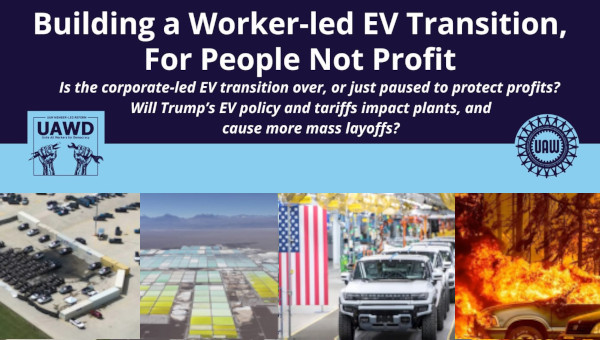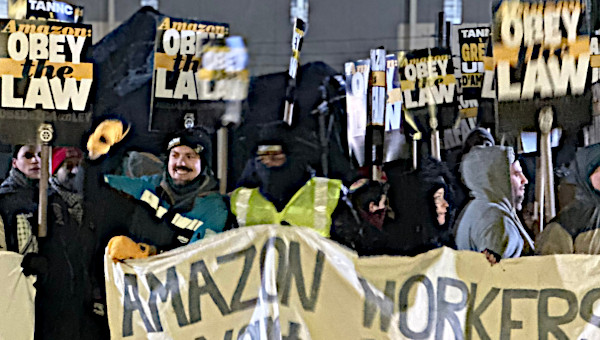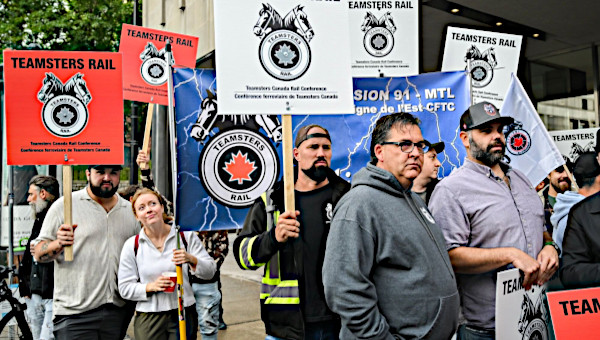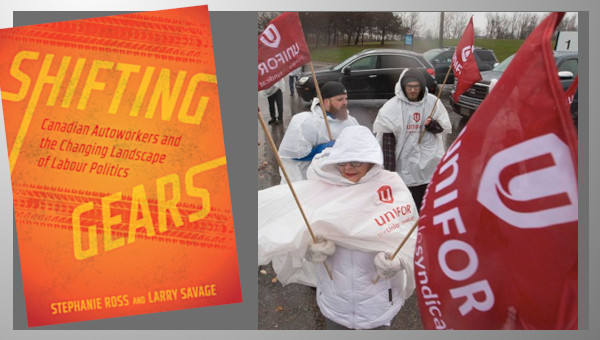Windsor Modules: The CAW-Magna Deal Delivers – Or Does it?
On November 7, 2007, the CAW made an historic announcement. The first collective agreement under the new CAW-Magna Framework of Fairness Agreement (FFA) was ratified at Windsor Modules, a plant of some 250 workers. The union published details of the agreement itself, but provided little information about the process.
As we learn more about that background some disturbing questions have emerged about whether CAW activists and members have been mislead. The unionization of this Magna plant and the impressive monetary agreement, it seems, were not the result of the FFA at all, but part of a more ‘traditional’ unionization process.
The New Collective Agreement at Windsor Modules
The gains in this new agreement do, at first sight, indeed seem very significant. According to the CAW press release:
“The three year agreement, ratified by over 87 per cent, includes an immediate $3/hour wage increase for production workers with annual improvements, a skilled trades program, layoff and job security protections, a women’s advocate, paid education leave and inter-plant transfer language.” (See CAW Web-site for further details).
Coming as it did in the midst of significant opposition to the FFA, and with the December CAW Council – the CAW’s ‘parliament’ of 800 delegates – quickly approaching, the timing seemed linked to ‘settling people down’. Who could argue with such obvious success?
The addition of the new Magna members and the impressive monetary package did swing a good many people towards favouring the deal. But the controversy did not go away. Concern remained over what was traded off over the long term: the independence and power of the union. The right of workers to withdraw their labour – the historical recourse of workers to balance the power of their employers – was not just postponed for six years (a compromise accepted in the Magna units the CAW currently has) but forever. And the shop steward system – the workplace structure workers developed to establish their daily independence from management (and still in place in current Magna agreements) – is replaced by a ‘joint fairness committee’.
The elected delegates to that joint committee deal with workplace issues in a ‘non-adversarial’ way. As the Fairness agreement makes clear, they “are not union representatives nor does their role include the representation of employees” (FFA, p.10). Replacing the 3-4 shop stewards that would normally be part of the union structure in a plant this size is a single ‘Employee Advocate’ (EA) covering all shifts.
The supporters of the FFA object to those arguing that the EA structure is undemocratic, but it is hard not to believe that the convoluted method of electing this union representative is designed to control workers’ democratic right to choose their representatives. Workers ‘apply’ for this ‘position’ and are ranked according to certain ‘criteria’ consistent with Magna’s principles; a short list of candidates is made up of those with the highest ranking (the language suggests that management is part of the selection process, but the union has insisted that management will be excluded); and then the national office selects the EA from the short list. Since the EAs from each Magna unit will make up the overall Magna bargaining committee, the national office effectively has the last say in determining the make-up of that national bargaining committee. This kind of centralized power over the right of workplaces to choose their own representatives contradicts the CAW’s commitment, expressed constitutionally, to not interfere in local elections.
No-one denies the importance of immediate gains for workers or that compromises are an inherent part of defending workers. But one of the most important lessons of the last thirty years revolves around the implications of only thinking short-term. While the corporations have built for tomorrow, the trade union movement – and the left more generally as well – have not. The price paid by workers for that short-sightedness is today evident and it grows daily.
The long-term significance of the FFA poses another set of questions. Why wasn’t it first discussed at the CAW Council? And even then, once the agreement was reached, why was discussion at the Council pre-empted by its actual implementation at Windsor Modules? These are not, it should be noted, constitutional questions but democratic ones. Collective agreements do not generally come before the Council for approval. But given how radical a turn it represents for the CAW and that it is with the largest employer in the entire auto sector, this is not just ‘another collective agreement.’ If this isn’t important enough to first get Council approval, what is?
But in addition to the above a further question has now emerged. The Toronto Star (November 17, 2007) has revealed that the union was actually recognized at Windsor Modules before the FFA was made. What actually happened?
Piecing Together the Background
to the Windsor Modules Agreement
In 2005 bargaining, the Windsor Chrysler unit of Local 444 was facing great uncertainty about jobs. The CAW had earlier negotiated control over outsourcing, but the local agreed to accept some outsourcing in exchange for guarantees on new investments. That outsourcing included the door components work, which went to Windsor Modules, a division of Magna (the plant would then supply both Windsor and St. Louis assembly).
Work that was previously done for close to $34/hr at Chrysler was now paid $12/hr at Magna. This itself seemed rather strange since Magna tends (as a union-avoidance tactic) to pay the average parts wage in the community, and that is estimated to have been close to $19/hr in the Windsor area. It would seem that paying such low wages, employing some former CAW members (this is unconfirmed) and supplying a neighbouring Chrysler plant, the plant was ripe for unionization.
In fact, the CAW local had apparently insisted that, along with the new investments, the outsourced work must be unionized. As the Local’s publication emphasized last summer (Local 444 News, June 2007, p. 7), the workers ‘must be CAW members with comparative benefits in the supplier industry.’ As the union publication reports, the two parties entered bargaining and on May 9th met to discuss the union’s proposals.
Clearly, and in contrast to the version later announced by the union, the CAW had received voluntary recognition at Magna and become the bargaining agent for Windsor Modules long before the FFA came into place. Magna’s response to the union demands is, in this context, telling: according to the same union publication, it rejected the proposal on the basis of ‘a document being crafted in Toronto that is a “Framework of Fairness”.’ This sheds quite a different light on this new agreement.
Rather than being the result of the Fairness agreement, the FFA seems to have been a barrier to an earlier resolution of the collective bargaining relationship. The lesson, it seems, is quite the opposite of what the union has presented. Unionization here was quite ‘traditional.’ It was based on a) the pressures from the local to get de facto recognition and raise standards in the outsourced work; and b) the positive response from Magna workers being paid outrageously low wages.
Whether or the CAW negotiators who subsequently bargained this deal under the FFA used the FFA to get a good monetary contract, a good monetary contract was certainly in the works here. The Chrysler local was determined to raise the wages (which had been cut far more than even the U.S. two-tier had brought) and simply moving to industry norms in the parts sector would have meant an increase of over 50%.
Moreover, since the workers would have had the right to strike had they joined the CAW in the traditional way, the possibility of a short strike and a disruption of Chrysler’s just-in-time assembly operations would have been very effective. A good contract could have been won, most likely without the actual necessity of a strike – while the unit would have retained the right to strike and its steward system.
From the FFA to Windsor Modules
When the CAW-Magna FFA was first announced, labour activists across the country were stunned. When it was further articulated as a new road for labour in the 21st century, one that suggested that workers needed to move ahead not alongside other workers but with their employers, this seemed to confirm the worst fears activists had about this direction. The notion that workers should disarm themselves by giving up the right to strike and their internal structures led to a wave of opposition in the CAW not seen for a very long time.
The union responded by toning down its new vision for labour and retreated to the practicalities of organizing workers in tough times. Echoing a familiar refrain, the union argued that ‘there is no alternative’ to accepting the negatives of the FFA and that what the union got in exchange could be built on. The unionization of Magna, the CAW national office argued, had been tried over the past thirty years, and it didn’t work.
We do not know if all of Magna can in fact be unionized outside of a union-company deal. The arguments about how difficult this would be are to be taken seriously. But we do know that to date the union has not in fact mobilized the resources and sustained commitment that might have made it possible. A look back is relevant. Autoworkers found creative ways to organize in the midst of the uncertainties of the Great Depression, when they had no union resources to back them up. Mineworkers put 100 young organizers into the field to organize steelworkers because they knew the dangers of being isolated. There has been no comparable crusade of dozens and dozens of energetic workers sent out to build a union at Magna.
The union did get a ‘neutrality’ letter from the Big Three in 1999 declaring that suppliers like Magna had no right to interfere in a representation decision that was for the workers to make. But the union never did the education amongst the Big Three workers to effectively carry out the intention of that letter. And when Integram, a crucial division of Magna with 800 workers was unionized, this did not lead to an inspired new drive; instead, the key young organizers involved were sent back to the line in the hope that now Magna might offer a ‘deal.’
The recent announcement bringing in new Magna members with a first contract that included an apparently large wage increase and much of what is standard in CAW agreements, did ease opposition to the FFA and restore faith among those who were wavering in their support of this new direction. Now, however, it seems that the announcement was both misleading in regards to how workers came to be CAW members, and was timed to co-opt momentum against the deal as the CAW Council approached.
Conclusion: Where is the CAW Going?
Even if the Magna deal is endorsed by the CAW delegates, many questions remain. Is Magna an exception or will it be a model? Will a Magna-type agreement be offered to Toyota next – and would that be a good or bad thing for Big Three workers? In the best case scenario, it will be at least a decade before the CAW gets all the units. What if, against expectations, the Magna workers in fact start fighting the company before then – will the CAW police the workers so they don’t disrupt the overall plan? Is Magna symbolic of not just a shift in organizing tactics but also in the ideology and politics of the union? •
For more news on the CAW-Magna agreement





